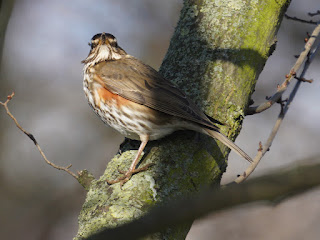A Blue Tit in the Rose Garden investigated a rose hip, then flew into a tree and sang. It's the male of a pair building a nest in a bush here.
A Great Tit preened in a tree just outside the Rose Garden. You can hear the Blue Tit shown in the previous video singing.
Two Wrens sang in the woodland at the foot of Buck Hill.
A Blackbird in the Dell gave the high-pitched alarm call that means 'predator overhead'. This call is given and understood by many small birds. I couldn't see the predator, but it may have been one of the local Peregrines passing by.
The Redwings were busy on the Parade Ground digging up worms. They will have found tens of thousands by now, but the supply seems endless.
The same Redwing in a tree taking a pause to digest its meal.
A very pale pigeon rested in the grass at Peter Pan. I think this colour combination would be called 'red and isabella', but what pigeon fanciers call 'red' is a pinkish bronze, usually darker than this. The pale brown colour called 'isabella' gets its name from a story that Isabel, daughter of Philip II of Spain, vowed during the siege of Ostend in 1601 not to change her underclothes until the town was taken. The siege lasted three years, during which her underclothes became very grubby. Another version attributes the vow to Isabel I, Queen of Castile, during her husband Ferdinand's siege of Granada, but that siege only took eight months.
A Grey Heron parent had a moment of peace in the nest while the chicks were dozing.
A young Herring Gull emerged from the water while diving to find a toy.
They love thing that roll, and when it found a tennis ball it played for several minutes, and then bore its toy off to have another go later.
I didn't see the pigeon-eating Lesser Black-Backed Gull, but in two hours between my first and second visit to his hunting ground he had caught and eaten his lunch, leaving the remains for a Carrion Crow.
A pair of Great Crested Grebes on the Long Water have been hanging around a half completed Coots' nest under the willow near the bridge with the clear intention of stealing it. This is the male.
A pair of Mute Swans have started gathering twigs for a nest behind the boathouse railings.
The Egyptian Geese on the north side of the Serpentine have lost one more gosling to the numerous and hungry gulls, but are doggedly guarding the remaining three.
A squirrel boldly stared at a dog, knowing that it was safe behind the fence. This is under the leaning Lombardy poplar tree at Peter Pan, whose roots are coming out of the path and lifting and tilting the railings. I was surprised that it withstood the recent storm.
Two more pictures from Barruecos sent by Tinúviel. First, a White Stork on one of the big granite rocks. I do wish we had storks here. They can live in Belgium, so the English climate wouldn't bother them.
This is the southern form of the Great Grey Shrike, Lania excubitor meridionalis, distinguished from the ones seen in Britain by having a pinkish buff front rather than pale grey.
Update: Bill Haines has just sent me a remarkable photograph of a Black-Headed Gull ringed by him which has turned up at Kengarags, near Riga in Latvia. The picture was taken there by Ruslans Matrozis last year on 28 March and has taken a while to arrive.
Bill ringed the gull as a second year male on 8 December 2020. Here is my picture of it in the park, taken on 4 February this year. It may not have left yet.


















































